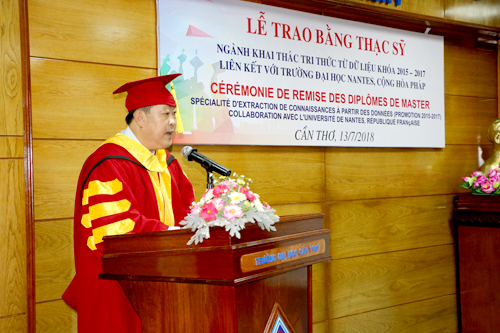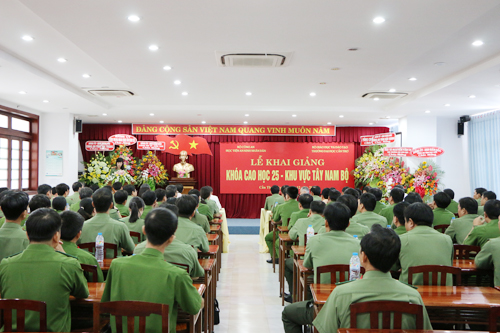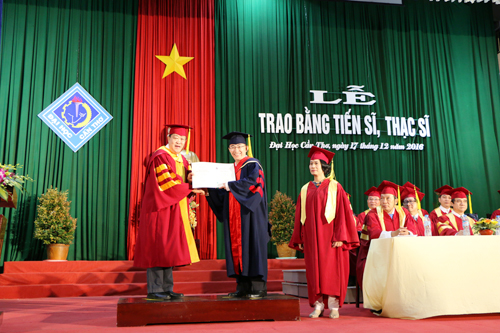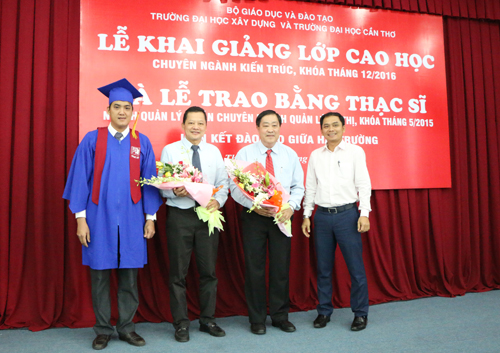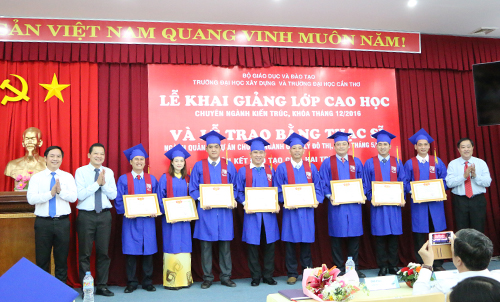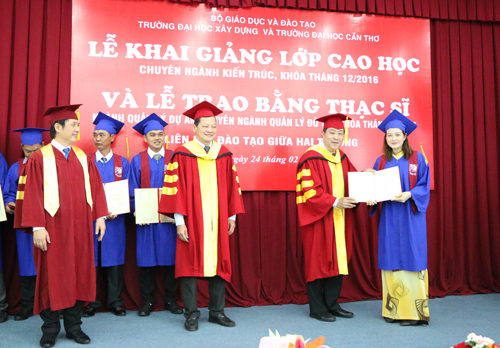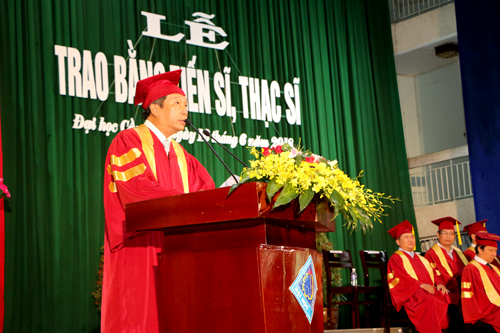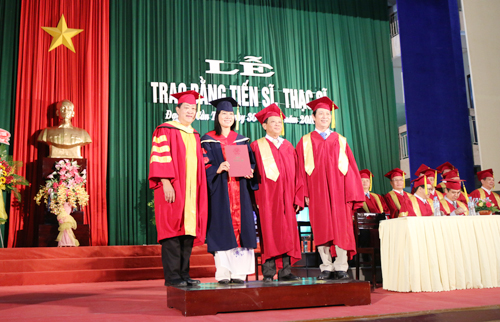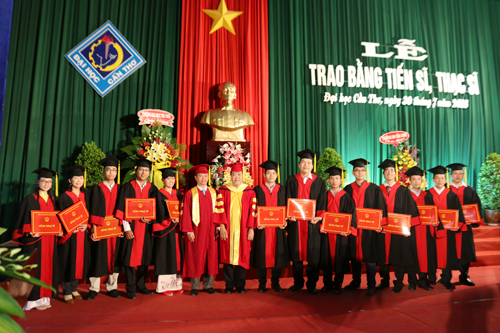
Tên đề tài: “Ảnh hưởng của lipid trong thức ăn chế biến lên sinh trưởng và tỉ lệ sống của ấu trùng cua biển Scylla paramamosain (Estampador, 1949)”.
Tác giả: Lâm Tâm Nguyên, Khóa: 2014
Chuyên ngành: Nuôi trồng thủy sản; Mã số: 62620110. Nhóm ngành: Nông-Lâm-Ngư nghiệp.
Người hướng dẫn chính: PGS.TS. Trần Thị Thanh Hiền - Trường Đại học Cần Thơ.
Người hướng dẫn chính: PGS.TS. Nguyễn Thị Ngọc Anh - Trường Đại học Cần Thơ.
- Tóm tắt nội dung luận án
Nghiên cứu được thực hiện gồm 4 nội dung (1) khảo sát hiện trạng sử dụng thức ăn trong sản xuất giống cua biển; (2) nghiên cứu hàm lượng và thành phần lipid (hàm lượng lipid, tỷ lệ dầu, hàm lượng lecithin và cholesterol); (3) khả năng thay thế Artemia bằng thức ăn chế biến và (4) ứng dụng các kết quả thí nghiệm vào ương ấu trùng cua biển ở qui mô sản xuất. Tất cả các thí nghiệm được thực hiện 2 giai đoạn ương nuôi: từ zoea 3 đến megalopa và từ megalopa đến cua 1.
Khảo sát tình hình sử dụng thức ăn trong sản xuất giống cua biển ở Đồng Bằng sông Cửu Long được thực hiện vào năm 2015 (105 hộ) và năm 2020 (100 hộ) 3 tỉnh: Bạc Liêu, Cà Mau và Kiên Giang. Kết quả cho thấy 100% chủ trại được khảo sát sử dụng thức ăn tươi sống (Artemia bung dù và ấu trùng Artemia mới nở) kết hợp với thức ăn nhân tạo (loại thức ăn dùng cho tôm biển) trong suốt chu kỳ ương nuôi ấu trùng cua. Lượng Artemia sử dụng trung bình 4,9±2,8 g/m3/ngày và thức ăn nhân tạo 7,1±1,6 g/m3/ngày. Tổng chi phí sản xuất trung bình 5,92±5,02 triệu đồng/m3/năm, trong đó thức ăn chiếm tỉ lệ cao nhất (73%) với Artemia chiếm từ 61% và thức ăn nhân tạo 12% vào năm 2020.
Đánh giá ảnh hưởng của hàm lượng lipid khác nhau (6%, 8%, 10%, 12% và 14%) trong thức ăn phối chế cho ấu trùng cua biển. Kết quả cho thấy nghiệm thức 12% lipid đạt chỉ số biến thái của ấu trùng zoea 3-zoea 5 (4,96), tỉ lệ sống (7,40%) và kích cỡ cua 1 tốt nhất và khác biệt có ý nghĩa thống kê (p<0,05) so với các nghiệm thức còn lại. Đánh giá ảnh hưởng của tỉ lệ dầu cá:dầu đậu nành khác nhau trong thức ăn phối chế cho ấu trùng cua biển gồm 5 tỷ lệ dầu cá (DC):dầu đậu nành (DN) khác nhau lần lượt là nghiệm thức không chứa dầu đậu nành (1DC:0DN) hoặc dầu cá (0DC:1DN), tỉ lệ DC:DN là 1:1 (1DC:1DN), dầu đậu nành gấp 2 lần dầu cá (1DC:2DN) và dầu cá gấp 2 lần dầu đậu nành (2DC:1DN). Kết quả cho thấy thức ăn phối chế với tỉ lệ dầu cá:dầu đậu nành là 1:1 thu được tỉ lệ sống megalopa và cua 1cao nhất. Đánh giá ảnh hưởng của bổ sung hàm lượng lecithin khác nhau (1%, 2%, 3% và 4%) và nghiệm thức không bổ sung lecithin (hàm lượng lecithin sẵn có là 0,57%) trong thức ăn phối chế cho ấu trùng cua biển. Kết quả cho thấy thức ăn bổ sung 3% lecithin (hàm lượng lecithin trong thức ăn 3.57%) cho chỉ số biến thái, kích cỡ và tỷ lệ sống (13,02%) của megalop và cua 1 cao hơn có có ý nghĩa thống kê so với các nghiệm thức còn lại (p<0,05). Đánh giá ảnh hưởng của bổ sung hàm lượng cholesterol khác nhau (3%, 0,6%, 0,9%, 1,2% và 1,5%) và nghiệm thức đối chứng không bổ sung (hàm lượng cholesterol sẵn có 0,18%) trong thức ăn phối chế cho ấu trùng cua biển. Kết quả cho thấy nghiệm thức 0,3% (hàm lượng chlosterol là 3,57%) đạt kích cỡ và tỷ lệ sống tốt nhất (12,03%) so với các nghiệm thức khác. Từ kết quả này có thể kết luận rằng thức ăn phối chế có hàm lượng lipid 12%, tỷ lệ DC:DN là 1:1, hàm lượng lecithin 3,57%, cholesterol 0,48% được xem là thức ăn thích hợp nhất cho ấu trùng cua biển từ giai đoạn zoea 3 đến cua 1.
Đánh giá khả năng thay thế Artemia bằng thức ăn chế biến (CB) từ giai đoạn zoae 3 đến cua 1 với chế độ cho ăn 5 lần/ngày gồm 6 nghiệm thức: (i) 5 lần Artemia+ 0 CB, (ii) 4 lần Artemia+1 lần CB, (iii) 3 lần Artemia+2 lần CB, (iv) 2 lần Artemia+3 lần CB, (v) 1 lần Artemia+4 lần CB, và (vi) 0 Artemia+5 lần CB. Kết quả cho thấy từ zoae 3 đến megalopa, tỷ lệ sống và kích cỡ megalopa ở nghiệm thức cho ăn 3 lần Artemia+2 lần CB Artemia khác biệt không có ý nghĩa thống kê (p>0,05) so với nghiệm thức cho ăn hoàn toàn Artemia. Từ giai đoạn megalop đến cua 1, nghiệm thức cho ăn hoàn toàn thức ăn thí nghiệm đạt tỷ lệ sống cao nhất. Ứng dụng kết quả thí nghiệm vào ương ấu trùng cua biển ở quy mô sản xuất được thực hiện 3 đợt trong 6 bể ương 1,3m3, mỗi bể ương nuôi 70.000 zoae 3, kết quả thu được tỷ lệ sống giai đoạn zoae 1 đến megalopa 3 trung bình 14.87±0,90% và từ megalopa đến cua1 là 80,29±4,5%.
Tổng hợp các kết quả nghiên cứu có thể kết luận rằng công thức thức ăn phối chế với 12% lipid, tỷ lệ dầu cá và dầu đậu nành là 1:1, hàm lượng lecithin 3,57% và cholesterol 0,48% được xem là thích hợp nhất cho ấu trùng cua biển từ zoea 3 đến cua 1. Thêm vào đó, từ zoea 3 đến megalopa, mức thay thế Artemia thích hợp bằng thức ăn thí nghiệm với chế độ cho ăn 3 lần Artemia và 2 lần thức ăn thí nghiệm trong ngày và giai đoạn megalopa có thể sử dụng hoàn toàn thức ăn thí nghiệm.
Từ khóa: lipid, thức ăn chế biến, cua biển, S. paramamosain, sản xuất giống
- Những kết quả mới của luận án
- Xác định được hàm lượng và nguồn dầu phù hợp để làm thức ăn cho ấu trùng cua biển S. paramamosain từ giai đoạn zoea 3 đến cua 1.
- Xác định được lượng lecithin và cholesterol phù hợp bổ sung vào thức ăn ương ấu trùng cua biển S. paramamosain từ giai đoạn zoea 3 đến cua 1.
- Lần đầu tiên xây dựng được công thức thức ăn chế biến đáp ứng nhu cầu lipid ương ấu trùng cua, giảm được lượng Artemia. Ứng dụng thành công vào sản xuất thực tế, nâng cao tỉ lệ sống ấu trùng cua biển S. paramamosain. cao hơn so với thực tế sản xuất hiện nay.
- Các ứng dụng/khả năng ứng dụng trong thực tiễn, các vấn đề cần tiếp tục nghiên cứu
- Ứng dụng kết quả nghiên cứu để sản xuất thức ăn chế biến ương ấu trùng cua biển ở qui mô sản xuất.
Các vấn đề tiếp tục nghiên cứu:
- Nghiên cứu này mang tính ứng dụng nên cần có những nghiên cứu cơ bản hơn về nhu cầu acid béo, acid amin..cho ấu trùng cua biển
- Tiếp tục nghiên cứu về các nguồn nguyên liệu protein làm thức ăn ương ấu trùng cua biển
- Research Abstract
The research was carried out with 4 different contents (1) survey on the current status of feed utilization in seed production of mud crab; (2) study on the lipid content and composition (lipid content, oil ratio, lecithin and cholesterol levels); (3) the possibility of replacing Artemia with formulated feed and (4) application of the study results to the larviculture of mud crab at a production scale. All experiments were performed with 2 rearing phase: from zoea 3 to megalopa and from megalopa to crab 1.
The survey on the status of feed use in mud crab hatchery production in the Mekong Delta was conducted in three provinces: Bac Lieu, Ca Mau, and Kien Giang in 2015 and 2020. The survey results revealed that 100% of the mud crab hatchery owners used live food (Artemia nauplii) combined with artificial feed (feed type for marine shrimp) during the crab larval rearing cycle. The average amount of Artemia used was 4.9±2.8 g/m3/day and the artificial feed was 7.1±1.6 g/m3/day. The mean total production cost was 5.92±5.02 million VND/m3/year, with feed cost accounting for the majority of the total (73%) with Artemia accounting for 61% and artificial feed accounting for 12% in 2020.
Evaluating the effect of different lipid levels (6%, 8%, 10%, 12% and 14%) in formulated feeds for mud crab larvae. Results showed that feed containing 12% lipid gave the best larval stage index of zoea 5 (4.96) and survival of megalopa (7.40%) and size of crab 1 that were statistically differed (p<0.05) from the other treatments. Investigating the effects of different ratio of fish oil: soybean oil in mud crab larvae with 5 different ratios of fish oil (DC): soybean oil (DN) namely feed without containing soybean oil (1DC: 0DN) or fish oil (0DC: 1DN), DC: DN ratio = 1: 1 (1DC: 1DN), soybean oil 2 times fish oil (1DC: 2DN) and fish oil 2 times soybean oil times (2DC: 1DN). It was found that the diet containing a 1: 1 ratio of fish oil: soybean oil, which is considered to be the optimum ratio of animal oil: vegetable oil in the formulated feed for crab larvae. Evaluating the influence of different supplementation levels of lecithin (1%; 2%; 3% and 4%) and control treatment without supplementing lecithin (0.57% available) in feed for crab larvae. It was found that the diet supplemented with 3% lecithin (3.57% lecithin in feed) obtained the highest size and survival rate (13.02%) of megalopa and crab 1. Evaluating the effect of supplementing various cholesterol contents (0.3%, 0.6%, 0.9%, 1.2% and 1.5%) and control treatment without adding cholesterol (available lecithin in feed was 0.18%) in experimental feeds for crab larvae. The results illustrated that the 0.3% cholesterol treatments (0.48% cholesterol in feed) had the highest survival rates (12.03%) compared to other feeding treatments. From these results, it can be suggested that the formulated feed containing 12% lipid, fish oil: soy bean ratio of 1:1, with 3.57% lecithin and 0.48% cholesterol are the most suitable for mud crab larvae from zoea 3 to crab 1 stage.
Evaluate the possibility of replacing Artemia with experimental feed (EF) from zoae 3 to crab 1 consisted of 6 treatments. Feeding was applied five times a day i.e. (i) 5 times Artemia+0 EF, (ii) 4 times Artemia+1 time EF, (iii) 3 times Artemia+2 times EF, (iv) 2 times Artemia+3 times EF, (v) 1 time Artemia+4 times EF, and (vi) 0 Artemia+5 times EF. Results showed that from zoae 3 to megalopa, the size and survival of megalopa in the group received 3 times Artemia+2 times EF was not significantly different (p>0.05) from those fed completely Artemia. Moreover, from megalopa to crab 1, animals fed solely experimental feed had the highest survival rate compared to other feeding regimes. The experimental results were applied in mud crab larviculture at a production scale in three batches, with each batch containing 70,000 zoae 3-stage stocked in six 1.3 m3 nursery tanks. At the end of rearing cycle, the average survival rates from zoae 1 to megalopa and from megalopa to crab 1 were 14.87±0.90% and 80.29±4.5%, respectively. These results suggested that a formulated feed containing 12% lipid, a 1:1 ratio of fish oil and soybean oil, 3.57% lecithin and 0.48% cholesterol could be the most suitable feed from zoea 3 to crab 1. Furthermore, from zoea 3 to megalopa, appropriate replacement Artemia with experimental feed by applying 3 times Artemia and 2 times experimental feed per day, while megalopa stage can use completely experimental feed.
Keywords: Lipid, formulated feed, mud crab, Scylla paramamosain, seed production
- Research Creativeness
- Evaluating technical aspects and current feed use in larviculture of mud crab paramamosain in the Mekong Delta.
- Determined the suitable lipid content and source in formulated feed for paramamosain larvae from zoea 3 to crab 1 stage.
- Determined the appropriate levels of lecithin and cholesterol supplemented to formulated feed for paramamosain larvae from zoea 3 to crab 1 stage.
- For the first time, an experimental feed formulation was developed to meet the lipid requirements of crab larvae paramamosain while reducing the amount of Artemia used. The successful application of experimental feed on a production scale enhanced megalopa and crabs 1 survival rates as compared to current production practices.
- The applications/potential applications in barramundi farming, and the perspectives of this study
- Apply the results of the study to the production of formulated feed for crab larvae at a large scale.
Issues of further research:
- This is an applied study; more basic research on fatty acid, amino acid requirements, and other aspects of mud crab larvae needs to be done.
- Continue to study on protein ingredients as a source of nutrition for mud crab larvae.
- Xem chi tiết nội dung luận án
- Xem thông tin đăng tải tại Website Bộ giáo dục và Đào tạo. (Nhập tên NCS vào ô tìm kiếm)





